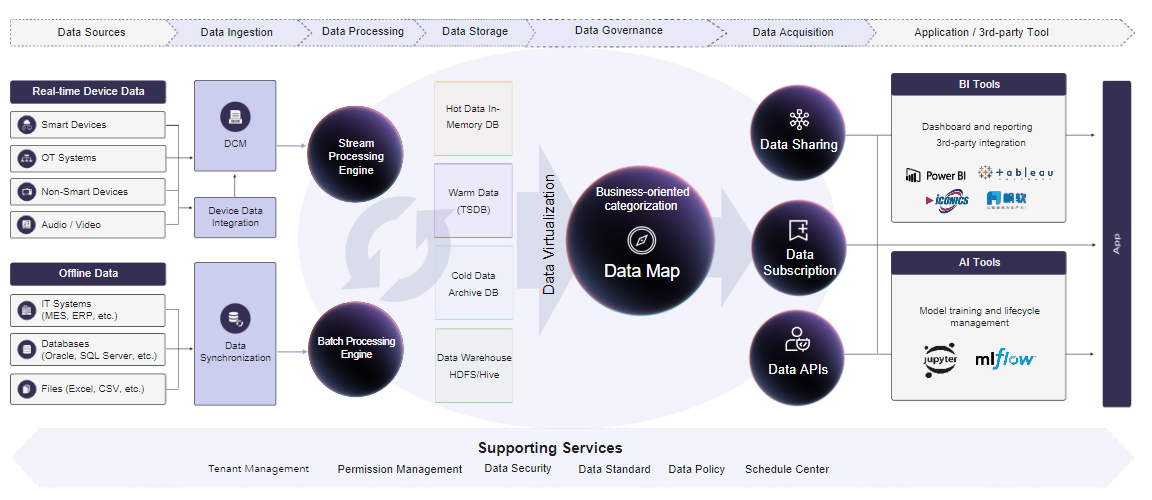EnOS Data Management¶
EnOS provides support for the full data chain in IoT scenarios, helping you manage the end-to-end data lifecycle, from data source, data injection, data processing, data storage, data governance to data acquisition.

Data Source Registration¶
EnOS enables you to synchronize data from your own data stores to the Hive data store in EnOS Cloud and from the EnOS Hive data store to your own data stores. You can manage your data stores that exchange data with EnOS Cloud through Data Source Registration. For more information, see EnOS Data Source Registration.
Time Series Data Management¶
EnOS Time Series Database (TSDB) provides efficient and stable storage and management for time series data that is ingested from devices or generated by the stream processing engine by having a variety of data storage options based on your data storage and reading requirements. Data is stored by categories (data type and storage time), thus reducing data storage costs and enhancing data reading efficiency.
With the Data Insights feature, you can view the latest data ingested from your devices and also generate a chart for time series data that is stored in TSDB by selecting a specific time range and device measurement points, which improves the efficiency of data analysis.
With the Data Deletion feature, you can delete the historical data (wrong data, informal data, or business data that is no longer needed) stored in TSDB to release storage resource and save data storage costs. For more information, see EnOS Time Series Data Management.
Note: The data storage policy must be configured before the devices start uploading data to EnOS Cloud. Otherwise, the uploaded device data will not be stored in EnOS TSDB.
Data Asset Management¶
EnOS Data Asset Management is a unified management center for enterprise data assets, which provides unified data asset management and query services for external applications, business scenarios, and business platforms to help transform the value of data assets. Through virtual data mapping and unified management of internal data, it eliminates information silos and data discrepancies while ensuring data security, and improves the value and utilization of data.
Data Sharing¶
EnOS Data Sharing provides powerful support for realizing data exchange of business systems within the enterprise. It mainly solves the problem of cross-organizational or third-party applications to access and use data, provides a way to use data within the scope of controllable permissions, breaks down data silos, realizes cross-enterprise business data sharing and synergy, and also solves the problem of secure data use.
Data Subscription¶
EnOS Data Subscription improves the API calling efficiency of applications with active data push, which supports subscription to various data types such as real-time asset data, asset alert data, and event data. You can use the provided Java SDK to retrieve the subscribed data. For more information, see EnOS Data Subscription.
Data Archiving¶
EnOS supports archiving and storing data from the real-time message channel, data from the offline message channels, real-time alert records, and data stored in TSDB. It provides flexible storage configurations to reduce your data storage costs. For more information, see EnOS Data Archiving.
Common Data Service¶
EnOS Common Data Service offers data providers a unified API framework and provides data consumers with standard API services across multiple domains, applications, and platforms.
Common Data Service can register, standardize, and route data from different data sources, and output data with the same semantics in the same access entry to unify heterogeneous data from various sources and accelerate application development. In addition, Common Data Service provides multiple advanced query capabilities to reduce application development difficulty and improve application development efficiency. For more information, see EnOS Common Data Service.